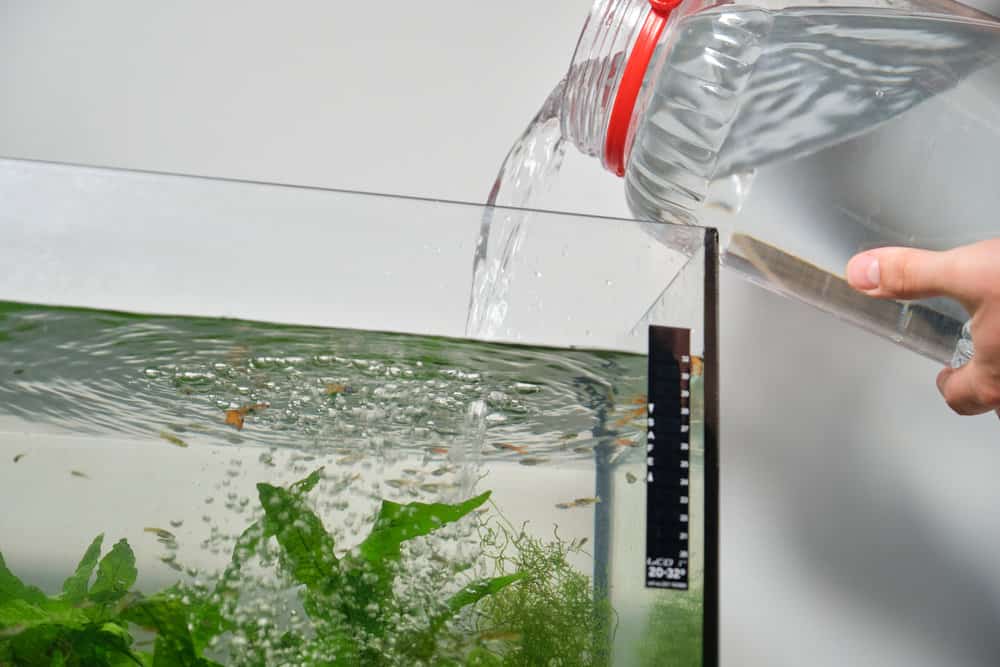How To Lower Ammonia In a Fish Tank?
Having ammonia in your fish tank can cause some big problems if not remediated in quick order. A high level of ammonia in a fish tank can be lowered by following the following steps:
- Do a water change of 25-50%
- Remove any dead or decaying plants, uneaten food, and deceased fish
- Limit the amount of food during feeding
- Check your filter for proper operation
- Increase filtration by adding filter media until ammonia is under control
- Add bacterial supplements to accelerate the nitrogen cycle
- Reduce the number of fish by temporarily moving to a holding tank
- Add ammonia-neutralizer products
- Increase aeration
- Use a water conditioner that detoxifies ammonia when doing a water change
Understanding the Cause of Ammonia
Ammonia typically enters an aquarium through:
- Fish Waste: As fish excrete waste, ammonia is a primary component.
- Decaying Organic Matter: Uneaten food, dead plants, and deceased fish can break down and release ammonia.
- Decaying Plant Matter: Dead or decaying plants can produce ammonia as they break down.
- Tap Water: Some tap waters can contain trace amounts of ammonia. It’s always a good idea to treat tap water with a water conditioner before adding it to an aquarium.
Actions for High Ammonia Levels
Test Ammonia Levels
Use a good testing kit and find out the levels before and after your water change. This should continue to be done daily until the ammonia levels are under control.
Immediate Water Change
Water Change should be your first immediate action after you discover that your ammonia level is too high. Initially, you should do a 50% water change and put in a conditioner that detoxifies ammonia. Make sure the new water is close to the temperature of the water you are removing so as to not introduce thermal shock to the fish.

A water change helps to reduce the high level of ammonia by providing the following:
Dilution – The freshwater that is being added back into the take will dilute the concentration of ammonia.
Removal of Organic Waste – When doing a water change, and using a gravel vacuum siphon, this will remove the uneaten food and fish waste. These are the primary sources of ammonia creation.
Oxygenation – Fresh water usually contains more dissolved oxygen than the old tank water. Introducing new water helps improve oxygenation, which aids fish respiration and supports the aerobic bacteria responsible for breaking down ammonia.
Stabilizes pH Levels – Over time, the pH of aquarium water can drop due to the accumulation of organic acids and other factors. Since ammonia becomes more toxic at higher pH levels, a dropping pH can act as a temporary buffer against ammonia toxicity. Regular water changes help stabilize the pH, preventing sudden fluctuations that could make ammonia more toxic.
Restores Essential Mineral – Over time, minerals in the water get depleted as they are absorbed by plants, fish, and other processes. Freshwater restores these minerals, which are essential for fish health.
Remove Potential Sources From the Aquarium
Any dead or decaying plants should be removed. Look carefully to find any possible decaying fish that are under rocks or plants that have died. If you see clumps of eaten food this should be removed. All the extra things that are in the tank are moving the ammonia levels up.
Long-Term Solutions
The following items should be considered in your long-term control of increased ammonia.
Proper Feeding: Try to always prevent overfeeding and gain an understanding of what the right amount of food is for your fish. What I typically will do is to feed them in very small amounts and make sure they are consuming their food before it falls to the bottom. Repeat this until you observe that the fish feed has slowed.
Regular Cleaning: Very important to regularly clean substrate, decorations, and equipment. You should not skip this routine as it can add up and get away from you. Also if you don’t stay on top of this you will start to notice an unwanted smell coming from your tank.
Natural Plants: If possible introduce live aquatic plants as they can help absorb ammonia.
Increase Aeration: This provides the benefits of improved oxygen exchange and circulation. You might consider adding another filter as additional will only help.

Biological Solutions
You should try and keep on top of the external resources that can be added to your fish tank that will help to keep ammonia levels. These include the following:
Beneficial Bacteria: These are commercially available products that contain live nitrifying bacteria. When added to the aquarium, these bacteria can help establish or boost the bacterial colonies that process ammonia and nitrite. Examples include products like “Tetra SafeStart,” “Seachem Stability,” and “API Quick Start.”
Biofilter Media: These are specialized filter materials designed to provide a high surface area for beneficial bacteria to colonize. Examples include ceramic rings, bio-balls, and sponges. Though the media itself doesn’t directly introduce bacteria, it provides an environment conducive to bacterial growth.
Monitoring Ammonia Levels
Continue testing for high ammonia levels. This should be a standard routine and can coincide with just before doing your regular water changes.
Conclusion
In conclusion, managing ammonia levels in an aquarium is very important to ensure the well-being of its inhabitants. Biological solutions play a pivotal role in this process, capitalizing on the natural nitrogen cycle.
By introducing beneficial bacteria, either through commercial supplements or established aquatic materials, and by fostering environments conducive to their growth, such as using live plants or specialized biofilter media, aquarium enthusiasts can effectively combat ammonia spikes.
Coupled with regular monitoring and maintenance practices, these strategies can ensure a balanced and thriving aquatic ecosystem.